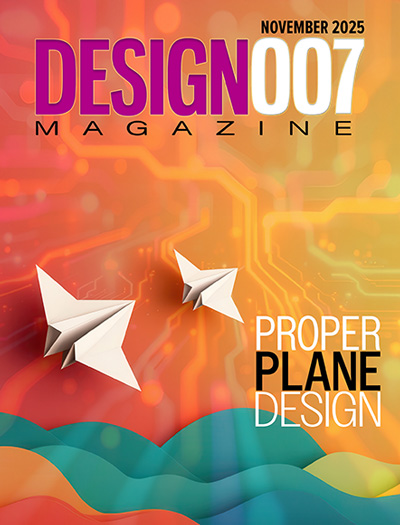-

-
News
News Highlights
- Books
Featured Books
- design007 Magazine
Latest Issues
Current Issue
Designing Proper Planes
Without planes, designers would have to create thousands of traces to accomplish the same objectives. Power planes provide low impedance and stable power, and ground planes stabilize reference voltage, improve thermal performance, and help preclude EMI issues.

Power Integrity
Current power demands are increasing, especially with AI, 5G, and EV chips. This month, our experts share “watt’s up” with power integrity, from planning and layout through measurement and manufacturing.

Signal Integrity
If you don’t have signal integrity problems now, you will eventually. This month, our expert contributors share a variety of SI techniques that can help designers avoid ground bounce, crosstalk, parasitic issues, and much more.
- Articles
- Columns
- Links
- Media kit
||| MENU - design007 Magazine
Simplifying Your Design
November 9, 2023 | I-Connect007 Editorial TeamEstimated reading time: 1 minute
It’s safe to say that millions of dollars, not to mention man-hours, are wasted each year because of over-constrained, overly complicated PCB designs. Much of this is due to the increase in signal speeds and rise times, even in “mature” PCBs, and the extra cost is already part of the budget.
For this issue on simplifying PCB designs, the I-Connect007 Editorial Team spoke with IPC instructor Kris Moyer about ways that designers can avoid overconstraining their designs and making them needlessly complex. As Kris says, streamlining your design comes down to having a solid understanding of fab and assembly processes and the silicon tradeoffs that can simplify or overcomplicate your design, as well as the need to start working with fabricators early in the cycle.
Andy Shaughnessy: What are some typical snafus and missteps that you see designers make to overcomplicate their designs?
Kris Moyer: Here’s what often happens: Let’s say you have one connector on your board that needs tight tolerance. But rather than dimensioning to just that connector, locally, designers will do a tight tolerance to the data from the global dimensioning system, which now constrains the entire board.
Or, if they need perfect coplanarity on a BGA part for good BGA mounting, they’ll put co-planarity back over the entire board where they don't need it, because regular chips, gull-wings, and so on don't need the same amount of coplanarity as a BGA—or they'll try to hold layer tolerances: “I need a 2-mil layer plus or minus 10%,” because they know that 10% is normal for tolerance, but they missed the part of the spec that says 10% or 1 mil, whichever is greater. Fabricators can't hold that tight a layer-to-layer tolerance when it's below a certain layer thickness.
Below about a 10-mil thickness, the best fabricators can do layer-to-layer is 1 mil for nominal processing; If you want to hold a tighter tolerance, you're paying for 100 to get five boards. That’s just a couple of examples. Another is overly tight hole tolerances: “I want to have 150-mil diameter hole ±1 mil.” Again, it's unreasonable, right?
To read the rest of this interview, which appeared in the November 2023 issue of Design007 Magazine, click here.
Testimonial
"We’re proud to call I-Connect007 a trusted partner. Their innovative approach and industry insight made our podcast collaboration a success by connecting us with the right audience and delivering real results."
Julia McCaffrey - NCAB GroupSuggested Items
Connect the Dots: The Future of Designing for Reality—Electroless Copper
11/26/2025 | Matt Stevenson -- Column: Connect the DotsOn a recent episode of I-Connect007’s On the Line With… podcast, we discussed electroless copper deposition—depositing a thin copper layer into the through-holes and vias of what will eventually become a printed circuit board. Specifically, it is a chemically catalyzed deposition of copper, mainly to the epoxy inside the holes (as well as on the entire surface of the board). Electroless differs from electrolytic in that electrolytic deposition relies on electricity.
UHDI Fundamentals: An Overview of UHDI Substrate Materials and Vias
11/13/2025 | Anaya Vardya, American Standard CircuitsThe rapid proliferation of 5G/6G communications, Internet of Things (IoT), high-performance computing (HPC), AI, and medical electronics has driven the need for increasingly compact, high-performance circuit packaging. UHDI, defined by feature sizes well below traditional HDI, addresses these demands by enabling ultra-fine lines, dense via interconnects, and embedded passive functionality. Understanding the materials and layering strategies in UHDI is essential for advancing both manufacturing and application design
Designers Notebook: Power and Ground Distribution Basics
10/29/2025 | Vern Solberg -- Column: Designer's NotebookThe principal objectives to be established during the planning stage are to define the interrelationship between all component elements and confirm that there is sufficient surface area for placement, the space needed to ensure efficient circuit interconnect, and to accommodate adequate power and ground distribution.
Connect the Dots: Designing for the Reality of UHDI PCBs—Drilling
11/04/2025 | Matt Stevenson -- Column: Connect the DotsUltra high density interconnect (UHDI) PCBs are changing the game in designing for the reality of manufacturing. With both consumer and industrial electronic devices becoming more advanced, the demand for UHDI PCBs will grow. That means we’re all likely to be designing more UHDI boards. UHDI advanced miniaturization technology challenges designers with regard to both board thickness and footprint. Designers will face more variables in every aspect of design creation. This is certainly the case with drilling.
The Marketing Minute: Marketing With Layers
10/15/2025 | Brittany Martin -- Column: The Marketing MinuteMarketing to a technical audience is like crafting a multilayer board: Each layer serves a purpose, from the surface story to the buried detail that keeps everything connected. At I-Connect007, we’ve learned that the best marketing campaigns aren’t built linearly; they’re layered. A campaign might start with a highly technical resource, such as an in-depth article, a white paper, or a podcast featuring an engineer delving into the details of a process. That’s the foundation, the substance that earns credibility.


